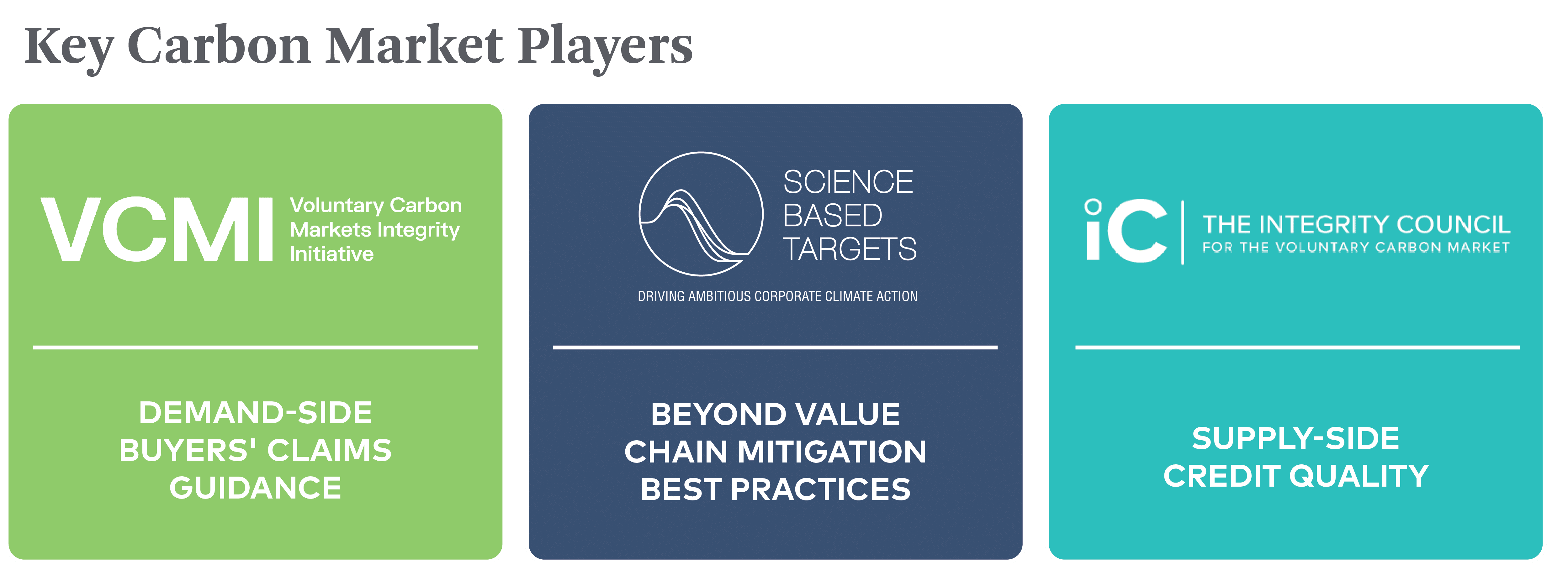The voluntary market (VCM) experienced heightened volatility in 2022, with an early, rapid price surge and plateau, followed by periods of recalibration. Despite this, there were numerous indications of healthy market growth, including the development of highly anticipated preliminary guidance on carbon credit quality and claims, increased focus on transparency and liquidity, and potential convergence of compliance markets with the voluntary market.
In this blog post, we will explore some of these market trends and discuss how the market developments in 2022 may have a lasting impact in 2023 and in years to come.
Initiatives to Support Market Growth
Both the growing interest and heightened criticism levied against carbon credits stem from the influx of organizations seeking to take action on climate change outside of their value chain. Since the inception of the VCM, standard bodies and registries have governed market interactions and have sought to improve credit quality. Efforts to codify a common framework for evaluating quality have only accelerated in the last year. Organizations such as the Voluntary Carbon Markets Integrity Initiative (VCMI), The Integrity Council for the Voluntary Carbon Market (IC-VCM) and the Science Based Targets Initiative (SBTi) are all working in parallel to provide clarity and guidance for both supply and demand-side market participants.
In Q3 of 2022, the IC-VCM released a draft of their Core Carbon Principles (CCPs), which aim to establish a global standard threshold for “high-quality” carbon credits and ensure consistency across the market. This initiative will evaluate carbon-crediting programs and methodologies against the CCPs, and will ultimately work with registries to label specific projects that are deemed “CCP-eligible”. The final version of the IC-VCM’s guidance is expected to be released later this year. Beyond developing a standardized framework, the IC-VCM could help bolster market credibility and facilitate investment in early-stage climate mitigation activities that are critical to achieving the goals of the Paris Agreement, including new carbon removal projects and other emerging technologies. Considerable feedback has been provided during the public consultation period, and it remains unclear what the finalized framework will include and how these standards will be adopted across the market.

The VCMI is also expected to release its own framework later this year. The goal of this initiative is to strengthen corporate guidance for making credible claims about the use of carbon credits on the pathway to net zero. Similarly, SBTi is expected to publish its recommendations on credible beyond value chain mitigation (BVCM). We anticipate that this guidance will encourage companies to maximize their climate impact and make transparent claims about their carbon credit purchases.
While the VCM is confronting some of these challenges, market participants are taking steps to improve transparency and liquidity through the increased use of trading platforms, standardized products, and project ratings. In the meantime, standard bodies and industry initiatives will be expected to answer pressing questions around how to improve project quality and incentivize the adoption of credible carbon credit claims. Whether leading governing bodies will align on their recommendations and how the market will respond to this new guidance remains to be seen.
Compliance and Voluntary Market Overlap
According to a recent BloombergNEF article, global compliance markets cover approximately 20% of global greenhouse gas emissions and reached a value of more than $850 billion in 2021. The need for VCM regulation is increasing alongside the development and expansion of global compliance market frameworks. Many market participants are speculating that the distinction between voluntary and compliance markets is becoming increasingly blurred and more markets could soon be overlapping.
The 2015 Paris Agreement further blurs the distinction between compliance and voluntary carbon markets. Article 6 of the Agreement, which was discussed at length at the last two COP summits, establishes an international carbon market and allows countries to trade carbon reductions and removals to achieve country-level GHG reduction targets. Article 6 also establishes an accounting mechanism known as “corresponding adjustments” to ensure only one country is counting the emission reduction toward its NDC, or Nationally Determined Contribution. Countries and airlines are expected to use credits with corresponding adjustments for compliance purposes, while questions still remain over how corresponding adjustments (or the lack thereof) will impact the kinds of carbon credit claims that can be made by companies.
“The 2015 Paris Agreement further blurs the distinction between compliance and voluntary carbon markets. Article 6 of the Agreement, which was discussed at length at the last two COP summits, establishes an international carbon market and allows countries to trade carbon reductions and removals to achieve country-level GHG reduction targets.”
As we have outlined, there is much in flux this year in the VCM. The initiatives above all aim to provide confidence and consistency in the market to help scale demand for critical carbon mitigation tools that will be required to meet the challenge of limiting warming to 1.5C. As regulatory bodies and voluntary standards announce updates throughout the year, 3Degrees will continue to provide guidance to clients on emerging best practices around claims and carbon credit procurement.


